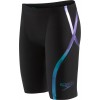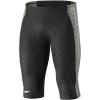Speedo Jammers are the go-to choice for many competitive and casual swimmers. And there’s good reason for that. Speedo has a stellar reputation for making excellent suits and continually pushing the envelope on swim jammer research and design.
However, Speedo offers so many swim jammers that it can be difficult to know which to choose. This article explains the differences in Speedo jammers and help you select the right pair. We will try to keep this article current, as Speedo retires old models and introduces new ones.
First. let’s answer the most basic question….
What are Jammers?
Jammers are tight-fitting shorts designed specifically for swimming. While they look a lot like biking shorts, they use special fabrics to stop them from filling with water and creating drag for the swimmer. The shorts often contain a blend of Spandex and nylon or polyester.
In 2008, Speedo and other manufacturers introduced full-body race suits made from polyurethane and neoprene. World records quickly tumbled and the swimming world was doused in controversy. FINA, the swimming governing body, stepped in and mandated strict rules on competition swimwear. One stipulation stated that, “Men’s swimsuits shall not extend above the navel or below the knee.” This rule, essentially, restricting race suits to swim jammers and swim briefs.
Jammers have become more popular than briefs in the competitive swim circuits. This is partly because manufacturers have developed new materials and production techniques that help swimmers to reduce drag while staying within the regulations outlined by FINA.
The first question you need to answer when buying a Speedo jammer is this….
Two Categories of Speedo Jammers
There are two categories of Speedo jammers — 1. Technical Suits, used for racing and 2. swim jammers – used for multiple purposes, including racing and training.
The jammers made specifically for racing are often called Technical Suits. They are high-performance suits made to give elite competitive swimmers an edge. These suits are approved by FINA and are the most expensive suits on the market. They have a limited number of uses and are, therefore, normally worn for a race.
The current line-up of Speedo Technical Suits include
LZR Elite 2 High Waist
LZR Elite 2
LZR Pro
Fastskin FSII
Aquablade
Multipurpose jammers are normally used for racing and training by competitive and leisure swimmers. Unlike technical suits, they are designed to withstand extended use. It’s common for swimmers to keep a training pair and a racing pair. As the training pair starts to fall apart, they’ll buy another suit for racing and relegate the former racing suit to practice.
The current line-up of Speedo Swim Jammers include:
PowerFLEX
Endurance
Quantum
Rapid Splice
Quark
Color Shards
Let’s take a look at the buying criteria and options for each category. First, the technical suits.
Speedo Technical Suits
Suits designed for elite competition
As mentioned, technical suits are designed for elite racing. These are the suits swimmers race in during the Olympics and World Championships.
Technical suits attempts to help the swimmer become as hydrodynamic as possible, while staying within FINA’s suit rules.
Aqualab is Speedo’s top-secret research and design facility. Here, suit designers and engineers research some of the world’s leading athletes to help engineer the next suit. Most developments in Speedo jammers revolve around two components — 1. the suit’s fabric and 2. the suit’s cut & stitching.
The Fabric
The fabric is, arguably, the most important feature of swim jammers and technical suits. Again, FINA provides strict rules around the type of fabric used in FINA Approved suits.
They state that suits must use “material consisting of, natural and/or synthetic, individual and non-consolidated yarns used to constitute a fabric by weaving, knitting, and/or braiding.” FINA also has regulations surrounding the coating and thickness of the materials, among other things. Manufacturers must submit each suit to FINA to get it approved for competition.
Speedo and Aqualab use the suit’s fabric to help reduce the swimmer’s drag coefficient in a couple of ways. First, they seek to find the most water-repellant mix of materials. Second, they strive to use fabric that compresses the swimmer’s muscles that are covered by the suit. Compressing the muscles helps reduce drag and helps with recovery time.
Speedo Jammer fabrics are mostly composed of a combination of nylon or polyester and Spandex. This fabric was originally made by DuPont and is now manufactured by Invista. Spandex is a synthetic fiber known for its high elasticity. In fact, the name Spandex was derived by using an anagram of the word “expands.” Spandex gives the muscle compression sought by most manufacturers.
Spandex is known by a variety of trade names. In North America, it is sold as Lycra. That’s what you’ll see on the Speedo labels. In Europe, Spandex is sold as Elastane, so that’s what you’ll see on labels from Arena, who are based in Italy.
While Spandex gives jammers a very snug fit when first used, the fabric is not very chlorine-resistant and will breakdown after continual use. This is the main reason that technical suits are designed to be used on a very limited basis. A fabric with high Spandex content helps to reduce drag, but will not last as long as suits with a lower Spandex content. Several companies have responded to this concern with new chlorine resistant materials. Invista has launched Xtra Life Lycra which, they claim, extends the life of the suit by 5-10 times compared to regular Lycra and PBT (polybutylene terephthalate) suits make similar claims.
Speedo doesn’t currently use Xtra Life Lycra or PBT in their technical suits, although they are introducing PBT into their swim jammers. (Discussed below.)
Speedo Jammers are not 100% Spandex. They normally include polyester or nylon. There are pros and cons of each. Polyester is extremely chlorine resistant and lasts longer than Nylon. However, Nylon is lighter and more comfortable, absorbs little water and dries quickly. Nylon doesn’t hold color or shape well.
Speedo offers four kinds of fabric in their racing jammers or technical suits.
- Aquablade: This fabric is Speedo’s cheapest technical suits. It’s made from a composition of 80% Polyester and 20% LYCRA® spandex. This fabric is used in their Aquablade Pro jammers.
- Fastskin: This fabric is used in the Fastskin FSII jammer. Like Aquable, the majority of the fabric is composed of Polyester (74%) but adds a larger balance of Lycra (26%).
- LZR Pulse: Speedo’s top-of-the-line race jammers are made with the LZR fabric. The original LZR fabric is still used in the LZR Pro jammer and is composed of 75% Nylon and 25% Lycra.
- LZR Pulse+: In 2013, Speedo released the second generation of its popular LZR Elite Jammers, their top of the line suit. The LZR Elite 2 uses LZR Pulse+ fabric, which has the highest Lycra content of any Speedo with 35% Lycra and 65% nylon.
The Cut and Stitching
In addition to using fabrics to reduce drag, Speedo also uses innovative production techniques. The suit’s stitching is one of the major areas Speedo focuses on. Traditional stitching produces raised seams, which create extra drag for the swimmer. Speedo offers “bonded seems” in their high end jammers. This produces flat seams.
Speedo also experiments with new fabric cuts, which attempt to improve the fit of the suit. The folks at Aqualab – Speedo’s research and development facility, study swimmers and stroke to find a cut and panel placement that helps compress the swimmer’s muscles, while offering maximum flexibility.
Speedo used Bonded Seams on the LZR Elite 2 jammers. This is a stitch-free technique that results in a low profile seam. The LZP Pro suits use a Four-Way Flat Sewn Seems which, although used traditional stitching, creates a lower profile seam than traditional stitching.
Here’s a list of Speedo’s most popular jammers. Click to read a full review of each.

|
Speedo LZR Racer X Jammer The LZR Racer X Jammer is Speedo's top-of-the line swim jammer. Most elite Speedo-sponsored swimmers race in this suit. A great option if this suit fits within your budget. |

|
Speedo Aquablade Jammer Speedo's Aquablade Jammer is a very good entry-level racing suit. It is priced well and offers good endurance, compared with many higher-end suits. |

|
Speedo LZR Pro Jammer Although the Speedo LZR Pro has been around a while, it's worth considering as an entry-level technical suit. The suit delivers many of the advanced features for a very reasonable price. |

|
Speedo Fastskin3 Super Elite High Waisted Jammer The Fastskin3 Super Elite is currently Speedo's top-of-the line suit. The suit is for serious competitors and is designed to be used with a racing system that includes a cap and goggles. |

|
Speedo Fastskin FS II Jammer This suit was once Speedo's premium suit. While they have introduced Fastskin3 as a superior model, the FSII still serves as a great entry-level technical suit. The price has been reduced making it a very inexpensive suit. |

|
Speedo Fastskin3 Elite Jammer The Fastskin3 Elite Jammer is one of Speedo's most popular suits. It uses Speedo's Pulse Power fabric and offers many of the same features as the Super Elite model for almost half the price. Great suit! |

|
Speedo Fastskin3 Super Elite Jammer The FASTSKIN3 Super Elite jammer is Speedo's top-of-the-line suit. It is part of the racing system, which includes the suit, cap and goggles. Excellent suit for the serious competitor without a budget. |
| Speedo LZR Racer Pro Jammer The LZR Racer Pro Jammer is one of Speedo's mid-range technical race suits for men. |
|
| Speedo LZR Racer Elite Jammer Speedo's LZR Racer Elite Jammer is their top-of-the-line swim jammer. It's constructed using LZR Pulse fabric and thermo-bonded seams. All-in-all it's one of the best suits on the market today. |